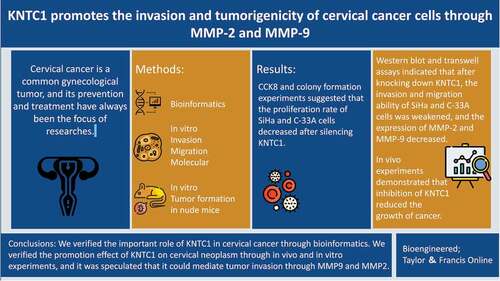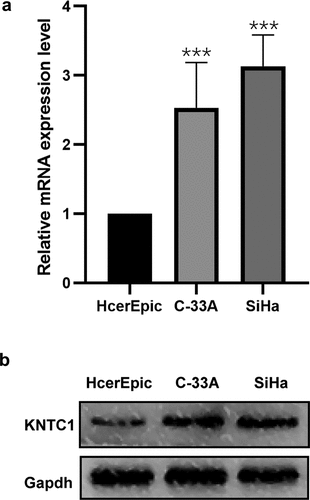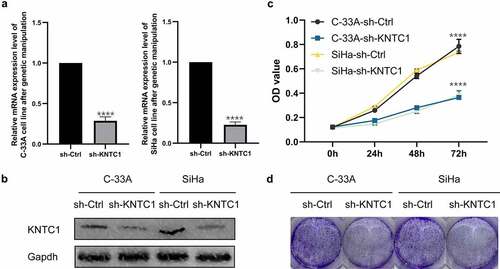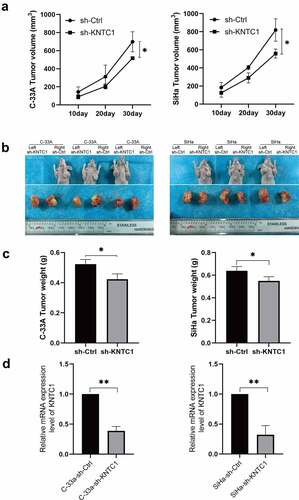Figures & data

Figure 1. Bioinformatics analysis. (a) Box plot shows the normalized processing results for each sample included in the analysis. (b) Principal component analysis of normal group and tumor group. (c) Gene probe volcano map of normal group and tumor group. (d) GO/KEGG enrichment map of differential genes. (e) Heat map of top 20 differential genes with high expression and low expression in the expression profile. (f) Box plot of KNTC1 expression in normal and tumor group of TCGA database. (g) ROC analysis of the expression level of KNTC1 in distinguishing patients with cervical cancer. (h) KM survival curve for analysis of the prognostic value of KNTC1 in patients with cervical cancer.

Figure 2. Expression of KNTC1 in cervical cancer cell lines. (a) qRT-PCR detected the mRNA expression level of KNTC1 in human normal cervical epithelial cells (HcerEpic) and cervical cancer cell lines C-33A and SiHa cell lines. (b) Western blot detected the protein expression level of KNTC1 in human normal cervical epithelial cells (HcerEpic) and cervical cancer cell lines C-33A and SiHa cell lines. KNTC1, kinetochore-associated protein 1.

Figure 3. Knockdown of KNTC1 inhibited the proliferation of cervical cancer cells. (a) After knocking down KNTC1, KNTC1 mRNA levels decreased in C-33A and SiHa cells. (b) After knocking down KNTC1, the protein level of KNTC1 decreased in C-33A and SiHa cells. (c) CCK8 detected the effect of KNTC1 knockdown on the proliferation of cervical cancer cells. (d) Colony formation assay was used to detect the effect of KNTC1 knockdown on proliferation of cervical cancer cells. KNTC1, kinetochore-associated protein 1.

Figure 4. Knockdown of KNTC1 inhibited the migration and invasion of cervical cancer cells. (a) Wound healing experiment was used to detect the effect of KNTC1 knockdown on the migration ability of cervical cancer cells. (b) Transwell assay was used to detect the effect of KNTC1 knockdown on migration of cervical cancer cells. (c) Transwell assay was used to detect the effect of KNTC1 knockdown on invasion of cervical cancer cells. (d) Western blot was used to detect the protein expression levels of MMP2 and MMP9 in cervical cancer cells after knocking down KNTC1. KNTC1, kinetochore-associated protein 1; MMP2, matrix metalloproteinase-2; MMP9, matrix metalloproteinase-9.

Figure 5. Knockdown of KNTC1 inhibited the tumorigenic ability of cervical cancer cells in vivo. (a) Tumor growth curve in nude mouse model. (b) Tumor display at the end of the experiment (day 30). (c) Comparison of tumor weights at the end of the experiment (day 30). KNTC1, kinetochore-associated protein 1. (d) qPCR results of subcutaneous tumor samples.

